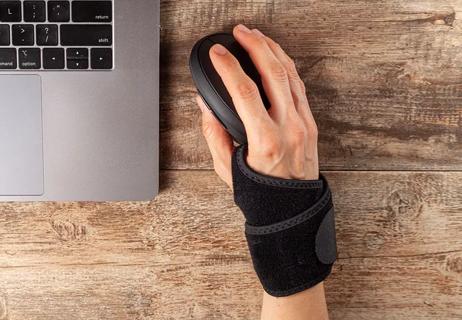These movements can help with pain, numbness and tingling in your hands and fingers

If you’ve been experiencing numbness, tingling and pain in your thumb, index finger, middle finger and forearm, you may have carpal tunnel syndrome. The common condition occurs when there’s an increase in pressure on your median nerve, which provides feeling to your thumb, index, middle and ring fingers.
Advertisement
Cleveland Clinic is a non-profit academic medical center. Advertising on our site helps support our mission. We do not endorse non-Cleveland Clinic products or services. Policy
Repetitive movements that use your fingers like computer use, factory work or hobbies can lead to carpal tunnel syndrome. Anyone can develop it, with your chance of getting carpal tunnel increasing as you age.
Carpal tunnel exercises can reduce your symptoms. For maximum relief, chiropractor Andrew Bang, DC, recommends these carpal tunnel stretches, which you can do throughout the day.
“This is a good stretch because the thumb gets so much overuse from cell phones,” says Dr. Bang. “This overuse leads to inflammation of the tendons.”
“Stretching these wrist flexors is imperative to treating or avoiding carpal tunnel. The wrist flexors are typically the most used muscle group in the forearm, so they tend to be over-developed,” explains Dr. Bang. “When they’re over-developed, they will cause collapse of the carpal arch, which can press on the median nerve — the nerve responsible for carpal tunnel.”
Advertisement
If you try these stretches for carpal tunnel and your pain worsens, you may need to see a doctor who can perform tests to confirm you have carpal tunnel syndrome. (Other conditions that could be causing you pain include arthritis and cubital tunnel syndrome.)
A doctor can also recommend a treatment to help alleviate your pain and discomfort. Treatment options include:
In addition to the carpal tunnel syndrome stretching above, you can make lifestyle changes like:
“There’s a lot you can do to prevent or treat carpal tunnel. If you’re still having symptoms despite daily stretching and making lifestyle changes, you need to reach out to your doctor to find the true source of your carpal tunnel-like symptoms,” Dr. Bang advises. “Other conditions, like fluid retention, pregnancy, menopause, thyroid disorders and inflammatory diseases, like rheumatoid arthritis, will mimic carpal tunnel syndrome.”
Advertisement
Learn more about our editorial process.
Advertisement

7 tricks to try to ease the tingling pain

This evidence-based practice is used to help manage pain, relieve menopause symptoms and boost your spirits

Plus, ways to keep your bones healthy and strong!

Bone health starts with proper nutrition, exercise and healthy lifestyle choices

This traditional Chinese medicine practice may boost mental health, immune function, balance and more

This fruit has clear nutritional benefits — but there’s little evidence it can prevent or treat illness

The supplement is OK for most people and may offer some potential benefits for kidney health

One is a supplement, the other is a prescription medication — both may be useful in managing Type 2 diabetes, but one has more research

If you’re feeling short of breath, sleep can be tough — propping yourself up or sleeping on your side may help

If you fear the unknown or find yourself needing reassurance often, you may identify with this attachment style

If you’re looking to boost your gut health, it’s better to get fiber from whole foods